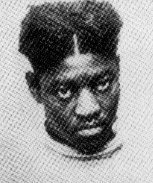
Haywood Patterson was, as much as anyone, at the center of the contoversy surrounding the Scottsboro Boys. It was Patterson's hand that was stepped on by a white boy while he was hanging to the side of a tank car, leading to a fight, the train's interception by a posse, and the eventual arrest and prosecutions of the Scottsboro Boys. It was Patterson, viewed as the most guilty and the most defiant of the Boys, who prosecutors chose as their first target after the initial convictions from the first trials were overturned. It was Patterson who faced the most trials and convictions (four between 1931 and 1937), did the hardest time in Alabama prisons, managed the most prison escapes (two), and whose story was first told in the book Scottsboro Boy.
Patterson was eighteen at the time he was accused of rape by Victoria Price and Ruby Bates. He was born in Georgia, the son of a sharecropper who later moved to Chattanooga to take work as a steelworker. Patterson left school after the third grade, working as a delivery boy for a time after he quit. He was already a veteran of the rails when arrested in Paint Rock in 1931, having ridden trains from Ohio to Florida to Arkansas, looking for work, since he was fourteen.
Patterson entered jail illiterate, but within eight months was writing letters home, reading, and challenging guards to name a state that he could not name the capitol of. His favorite prison reading, when he could get his hands on it, was the magazine True Detective. Patterson's smarts, his enterprising nature, and his defiance helped him tolerate the tough conditions of Alabama prison life better than most of the other Scottsboro Boys. Patterson, however, was given to rapid mood swings; one letter might be hopeful and upbeat, while in the next he might be complaining of "nightmares and restless moments." Throughout the early years of the Scottsboro cases, Patterson was recognized by the ILD as being the most loyal, most militant, and most spirited of the Boys.
After being falsely accused of rape in 1931, Patterson spent the next sixteen years in Alabama courtrooms and prisons. Tried four times, Patterson was convicted and sentenced to death three times, before receiving a seventy-five year sentence from his fourth jury. Patterson, either awaiting trial or serving time, spent time in jails and prisons in Scottsboro, Decatur, Birmingham, Kilby (the death house), and Atmore.
Prison life in Alabama was never easy, but some times were especially tough. One night, the night originally set for his own execution, Patterson watched and listened from his own six-foot by nine-foot cell as another inmate was electrocuted in a nearby room at Kilby. Of the experience Patterson said, "If I live to be 100, I'll never forget it." Atmore, a prison near Mobile, was the hell-hole of hell-holes. Atmore was filled with sadistic and even murderous guards, murderous inmates, rampant homosexual rape, and venemous snakes. Several times he was whipped. He was left without food for as long as a week at a time. He was kept in solitary confinement. He was surrounded by so many poisonous snakes that he was driven to tempting fate by draping them over his shoulders or putting them inside his shirt. On one occasion the prison bookkeeper offered two other black inmates $50 each to kill Patterson, but instead they warned him. In February 1941, he was stabbed twenty times, puncturing his lungs, by an inmate paid by a guard to kill him. Deprived of normal outlets for sex, Patterson became an aggressive homosexual ("a wolf") with his own "gal-boy." He attacked another prisoner with a switchblade for having sex with "his kid": "He didn't try to take my gal-boy away from me after that; nobody did."
Patterson held a variety of jobs in prison. He swept floors, worked rice and corn fields. For some time he ran an unofficial general store out of his cell. At Kilby, Patterson was responsible for carrying dead inmates out of the execution chamber.
Patterson managed two escapes. The first in April, 1943 gave Patterson five days of freedom before he was returned to Atmore to face even harsher treatment from prison guards. The second escape occurred on July 17, 1947, when Patterson was working on a prison farm. He and a number of other inmates began running through tall rows of corn, then out into woods, through snake-infested creeks. Cornered by three dogs, Patterson drowned two before scaring off the third. After a few close calls, Patterson made his way to Atlanta, then Chattanooga, then to the home of his sister in Detroit. At age thirty-six, Patterson was able to enjoy his first beer.
For the next three years, Patterson lived underground. He rediscovered women. He made contact with Scottsboro supporters. He, at the urging of I.F. Stone told his story in a book published in 1950, The Scottsboro Boy. Shortly after publication of his book, Patterson was arrested by the F.B.I. Alabama asked that Patterson be returned to Alabama, but Michigan Governor G. Mennen Williams refused extradition after a nationwide letter-writing campaign was mounted on Patterson's behalf.
In December, 1950, Patterson was arrested in connection with a barroom brawl that resulted in the death of another man. Patterson was charged with murder. Patterson claimed self-defense. His first trial resulted in a hung jury, a second ended in a mistrial, and a third resulted in a manslaughter conviction. Less than a year after Patterson returned to prison, on August 24, 1952, he was dead of cancer at age thirty-nine.
